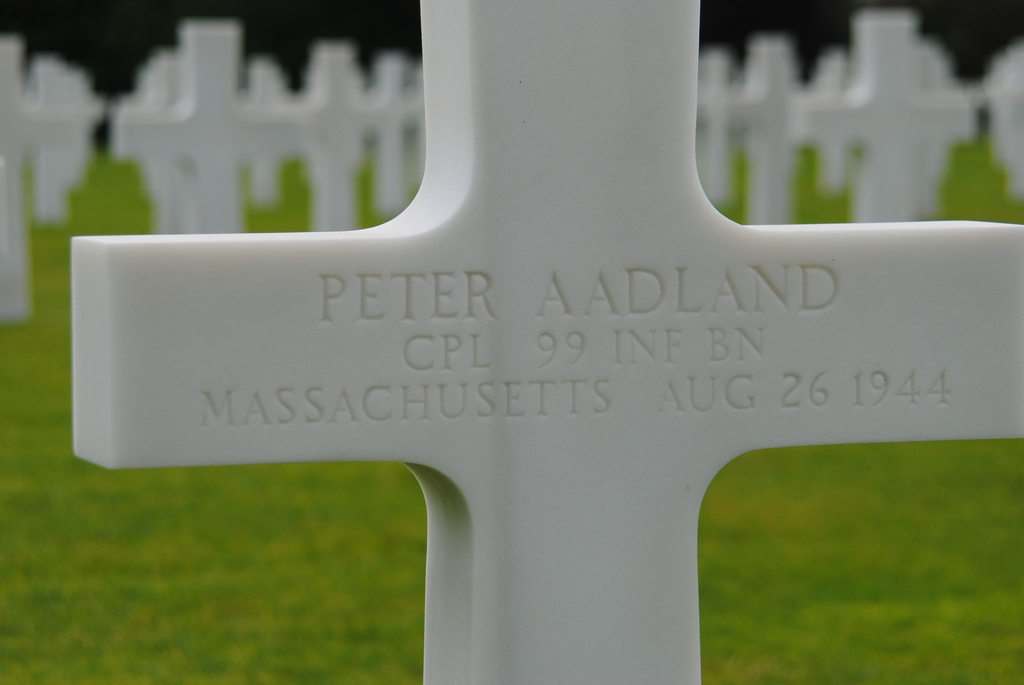Corporal Peter Aadland (Adland) Cenotaph Memorial - Viking Battalion
Details:
The cenotaph is located on the grounds of the school named in Peter Aadland’s honor.
The cenotaph is a rough engraved oblong stone about 5 feet high with the symbol of the 99th Infantry Battalion (Separate) (Norwegian) above the engraving.
The cenotaph remembers Corporal Peter Nikolaisen Aadland (Peder Adland) of Company D, 99th Infantry Battalion (Separate) (Norwegian). Aadland was a Norwegian immigrant who was born in Akrehamn, Norway and worked as a fisherman. He immigrated to the US (Fairhaven, Massachusetts) in 1938 becoming a citizen after his 1942 enlistment. He was recruited into the 99th Infantry Battalion – a Norwegian-American unit. Corporal Aadlund was killed in combat near Elbeuf, France on August 26, 1944 when the 99th Infantry Battalion was attached to the 2nd Armored Division.
Corporal Aadland is buried in the Normandy American Military Cemetery (Plot A; Row 21; Grave 22). A cenotaph to Aadland is located in his town of birth.
Background of the Viking Battalion (99th Infantry Battalion – Separate):
In the two years following the German invasion of neutral Norway, in April 1940, Norwegians and Norwegian-Americans in the United States struggled to find ways to come to the aid of their homeland. Here begins the tale of over thousand men whose fate became tied to the War Department’s secret plans.
The 99th Infantry Battalion (Separate) was activated in August 1942, at Minnesota’s Camp Ripley. The unit quickly grew and moved to Fort Snelling near Minneapolis. By mid-December the unit received orders to move to the newly completed Camp Hale, Colorado. The Battalion was identified as a “separate” unit since it did not belong to a regiment. Composed of Norwegian citizens and Norwegian Americans, the unit engaged in grueling winter and mountain warfare training at elevations above 10,000 feet.
By August 1943 the unit was combat ready and moved to Europe.
Landing two weeks after D-Day, they fought across Northern Europe to the German border with the second armored division. With the 30th Infantry Division they helped encircle the historic German capital of Aachen and held the line during the bitter winter fighting around Malmedy during the Battle of the Bulge.
In January 1945, the Battalion joined the veterans of the First Special Service Force, Darby’s Rangers and the 552nd Anti-Tank Company in the new 474th Infantry Regiment. In April the Regiment joined Patton’s third Army for the final drive to Germany. Within hours of Germany’s surrender, the 99th began its last secret mission when the Regiment started preparations for their movement to Norway.
The 99th Infantry Battalion (Separate) earned five battle stars: Normandy, Northern France, Rhineland, Ardennes, and Central Europe. And During 101 days in combat, the Battalion suffered the loss of 54 men killed, and 207 wounded. Fifteen Battalion members received the Silver Star, and 20 men were awarded the Bronze Star.
For more information visit: http://www.99battalion.org/
Special thanks to Mr. Jens Inge Egeland for assistance in documenting this memorial. Mr. England, working with the 99th Infantry Battalion Foundation, added the Viking Battalion Insignia to the cenotaph.
Monument Text:
The text is written in Norwegian and reads:
PEDER N ADLAND
21-7-1910
falt
i fridomskampen
i frankrike
26-8-1944
reist av sambygdingar
A translation of this in English:
Peder N. Adland
July 21-1910
Died
in the fight for freedom
in France.
August 26, 1944
erected by his fellow townspeople
Commemorates:
People:
Units:
2nd Armored Division
99th Infantry Battalion (Separate) (Norwegian)
Office of Strategic Services (OSS)
OSS-Norwegian Operational Group (Norso I/ Norso II)
United States Army
Wars:
WWII
Battles:
Operation Rype
Other images :





